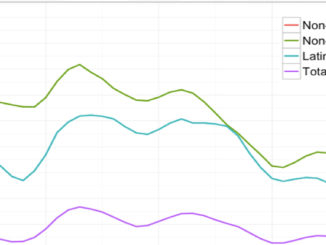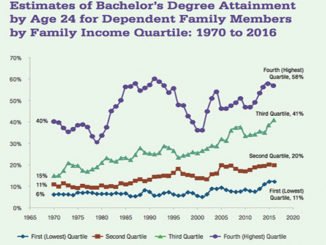
With the election of Donald J. Trump and a Republican Congress, as well as the confirmation of a school-choice activist as Secretary of Education, the moment for national action on school choice has arrived. The safe bet is that Trump will want to “go big” and try to reshape the educational landscape—and the electoral map—by backing an audacious school-choice plan. The big question is what that plan should look like.
The best strategy would be to go all in on the approach with the biggest and widest impact: a federal scholarship tax credit. Under a scholarship tax credit, taxpayers would receive a tax credit for contributing to a K–12 scholarship organization. A tax credit reduces a taxpayer’s tax bill by the amount of their donation. In contrast, the existing charitable donation simply reduces the donor’s taxable income. By making donations subject to a tax credit, philanthropy would easily flow to scholarship organizations, allowing those organizations to award scholarships to millions of students nationwide.
Because this tax incentive would be in the federal tax code, school choice would be realized instantly in all 50 states—with a minimum of red tape and bureaucracy. If the tax credit were approved in 2017, scholarship donations would start flowing in 2018.
This approach has several advantages over vouchers funded out of the federal budget: no existing federal money expected by school districts would be affected; no state money would be involved, thus avoiding legal conflicts with constitutional provisions that bar the use of state and local money for religious schools in 37 states; and, as a pure federal initiative, state laws and tax codes would remain unaffected.
A real-life example of how such a program might operate exists in Florida, where a scholarship tax credit was adopted through the efforts of then-Governor Jeb Bush and Tampa venture capitalist John Kirtley. The highly successful program now offers more than $500 million in scholarships serving about 100,000 students. Sixteen other states also have scholarship tax credit laws.
If the president or Congress wanted to cap a federal tax credit at $20 billion—the amount Trump proposed using to support school choice during his campaign—the Florida program also shows how such a cap could be implemented. Florida simply has donors apply for tax credits on a first-come, first-serve basis. To wrap your mind around this, just think of making a dining reservation on OpenTable.com, buying tickets from Ticketmaster, or ordering a product in limited supply on Amazon.com. The technology to allocate credits within an overall cap is straightforward.
A scholarship tax credit that benefits everyone
If the Trump administration embraces the scholarship tax credit idea, what should it look like?
Cast a wide net: The tax credit should encourage charitable scholarship donations from corporations and individuals. In some states, including Florida (which does not have an individual income tax), the programs apply only to business taxes.
Don’t forget the middle class: The bill should encourage scholarships not just for low-income families but also for working-class and middle-income families. With stagnant wages, exotically high college tuition bills, and, in many urban areas, a high cost of living, many middle-class families are squeezed and need help as well. These middle-class families include many labor-union households, including police, firefighters, sanitation workers, nurses, and construction workers.
Allow scholarship levels to match tuition: A mistake many states make is setting a maximum scholarship amount that is too low. A low scholarship cap (say, $1,000 to $1,500) will prove too restrictive to provide value to poor families (who can’t afford the balance of the tuition bills) or to encourage the founding of new schools or an expansion of existing schools. The goal should be to expand the range of choices available to families, not simply to provide targeted financial relief.
Don’t micromanage: The Every Student Succeeds Act prohibits the Secretary of Education from imposing national education standards on states. The same hands-off policy should apply to private schools chosen by scholarship recipients. The so-called accountability debate is best held at the state level. The federal government should have no role whatsoever in establishing standards for private or religious schools.
Steer clear of the culture wars: Politicians on the Left—many of whom oppose religious schools or church teaching on social issues—will attempt to insert “poison pills” into scholarship tax credit legislation to reduce support for the bill among social conservatives. These attempts should be viewed as the pure mischief that they are. Hot-button social issues like transgender bathrooms, conversion therapy, contraceptive coverage, discipline, and curriculum adoption will be resolved by policymakers at the state or local level. Scholarships for needy children should not be held hostage by such issues.
The risks that come with federal intervention
Pursuing school choice at the national level is not without risk. The autonomy of private schools and the liberty guaranteed by the Constitution ensure that protecting the rights of people of faith is not merely a policy preference. The Trump administration and school-choice activists need to sweat the details. A school-choice bill that morphs into legislation that tramples religious liberty or turns private schools into cookie-cutter versions of public schools would not be a win for “choice.”
What makes private schools a crucial element of school choice is the fact that they offer different options for parents. Some parents are attracted explicitly because they want their faith respected and affirmed. Others are attracted because they are looking for a different, safer, or higher quality alternative to the public school in their neighborhood.
We need to ensure that we don’t diminish the distinctiveness of these choices by allowing opponents (or even allies) to insert language that would undercut school autonomy or religious liberty.
A rebuttal to philosophical objections
Some on the Right, including my forum partner Neal McCluskey, argue that a federal scholarship tax credit assumes a federal role in education that is not supported by the Constitution. In reality, the pristine world he imagines changed a long time ago. The federal government has played a major role in Title I funding, the Individuals with Disabilities Education Act, Title IX, and postsecondary student aid, and none of those programs have been ruled unconstitutional. Education, of course, is mainly a state and local responsibility, but the federal role remains and is nontrivial.
The other inconvenient fact for his argument is that the federal tax code has long operated independently of state tax codes. In this country, state approval is not required for federal tax rates or preferences. Federalism can still exist because state tax codes—like any state laws—can operate alternative programs within each state.
Similarly, the federal government already includes a tax preference to encourage donations to scholarship organizations. It is called the charitable deduction. A federal scholarship tax credit would simply raise the value of that deduction. This would not represent a new, intrusive role for the federal government.
Seventeen states already have scholarship tax credits at the state level. None of these programs have been destroyed by the parallel existence of the federal charitable deduction. And none of them would be adversely affected by the federal government raising the federal tax incentive even higher.
All that would be required is ensuring that donors do not get more than a dollar’s worth of benefits for every dollar they donate. Accomplishing this is just as easy as stipulating that when you buy a charitable dinner ticket, you must back out the value of the meal from the amount you claim on your federal taxes. Similarly, anyone in a state with a state-level scholarship tax credit would need to back out any benefit they receive from their state tax code to make sure that the combination of federal and state tax incentives does not exceed the value of the donation.
Another important factor to remember is that under a federal scholarship tax credit, no federal money would go to school choice. Private individuals and businesses would donate their own money to private nonprofits that would, in turn, provide scholarships to private individuals. The federal government would simply refrain from taxing some income in order to make these donations more attractive.
This simplicity is why scholarship tax credits should not induce any more federal regulation than the charitable deduction that already encourages such donations at a lower percentage level. Nonprofit scholarship-granting organizations already exist across the country, so we don’t need a new bureaucracy or a big federal spending program. We just need to encourage a higher volume of private charitable donations to these private organizations, which the IRS already authorizes to receive charitable donations. It’s that simple.
The tax-reform bill juggernaut
Once a well-designed bill is crafted, it still needs a strategy for passage. The narrowness of Secretary of Education Betsy DeVos’s confirmation vote suggests that a stand-alone bill is unlikely to succeed. A better approach would be to include the scholarship tax bill in the broader tax-reform bill that Trump has vowed to push through this year.
While reducing the number of tax credits and deductions in favor of lowering tax rates on individual and corporate income is the primary aim of this bill, as with all major tax bills, there will be exceptions. For example, the child tax credit and the earned income tax credit remain very popular, even among congressional Republicans. It is not a stretch to include school choice in the same category.
The rationale for granting school choice special treatment is simple: without access to quality schools, students have a higher chance of dropping out, dealing with family dysfunction, committing crimes or going to prison, failing to find employment, abusing drugs and alcohol, experiencing poor health, and having to cope with a variety of other social ills. Using the tax code will also make it easier to avoid the regulatory overkill that typically is associated with spending programs—horrors that McCluskey has catalogued.
Potential political gains
Expanding school choice was one of President Trump’s central campaign promises. A scholarship tax credit is the only viable way to do so for families in all 50 states.
With his message of economic populism, Trump was able to win crucial states like Florida, Ohio, and North Carolina and even formerly blue ones like Pennsylvania, Michigan, and Wisconsin. In each of these states, school choice has great resonance.
A school-choice victory would help the president expand his base in those states and put other states in play. The adoption of a scholarship tax credit in 2017 would allow scholarships to flow to millions of families in 2018, enabling President Trump and his congressional allies to reach new voters in the midterms and the 2020 presidential election.
A scholarship tax credit appeals to a diverse coalition of supporters: economically disadvantaged, working-class, and middle-class voters; African American and Hispanic clergy and parents; urban Catholics, Orthodox Jews, and evangelical voters; and a large swath of the labor-union movement (a scholarship tax credit proposal in New York is supported by 30 labor unions).
Again, the best strategy is to go big, not small. Because the teachers unions will oppose any school-choice bill, making a school-choice bill narrower or smaller will shrink the coalition of supporters while leaving the opposition undiminished.
Sometimes the right thing to do is also good politics. Hopefully, the president will seize this historic opportunity.
Thomas W. Carroll is president of the Invest in Education Foundation.
This is part of a forum on President Donald Trump’s $20 Billion school choice plan. For an alternate take, see “For the Love of Choice, Don’t Federalize It” by Neal McCluskey.



